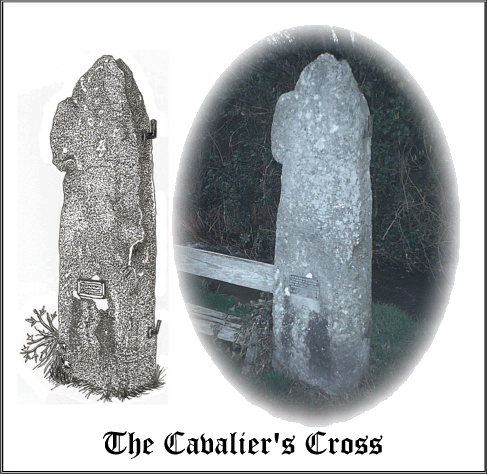
In a field just outside the town of Bovey Tracey stands a forlorn looking granite cross, it is sometimes known as Longston Cross or Challabrook Cross. At some time in the past it has been used as a gatepost as is evident from the two rusty gate hangers that still protrude from its battered shaft. It also looks as if the arm was smashed off in order to create a straight edge from which to hang the gate. A small plaque marks the fact that at one time the cross was used to mark the grave of a Royalist Officer that was killed nearby in 1645 in the battle of Bovey Heathfield where the Roundheads defeated the Royalist army. It states:
“This old cross once marked the grave of a Royalist officer who fell near here in 1645 when Cromwell’s troops defeated the Royalists – A. J. Wyatt 1923“.
A story goes that this particular Royalist officer called Longston, (hence the name Longston Cross) was very popular with the troops he commanded. Following his death at the battle of Bovey Heathfield his men went in search of a memorial stone to mark his grave. They came across the old cross at some unknown location and took it back to his burial site, presumably somewhere near to the battlefield.. At some point in time the cross was removed only to resurfaced in 1882 where it was serving as a gatepost at Challabrook Farm. Evidence of this can be seen by the rusty gate hanger still in situ today The cross was actually rescued, restored and resited to its current location by a Mr A. J. Wyatt in 1923. Harrison, p.155.
To further add insult to injury a 14 x 12cm cross has been incised on its south-eastern face which may have been a later addition although today there is little evidence of this. Today the cross stands at a height of 1.7m and a shaft circumference of 1.37m, what is left of the arms spans a tragic 48cm.

© Tim Sandles 2007

Sandles, T. 1997 A Pilgrimage to Dartmoor’s Crosses, Forest Publishing, Liverton.
Harrison, B. 2001. Dartmoor Stone Crosses. Tiverton: Halsgrove Publishing
 Legendary Dartmoor The many aspects past and present of Dartmoor
Legendary Dartmoor The many aspects past and present of Dartmoor
